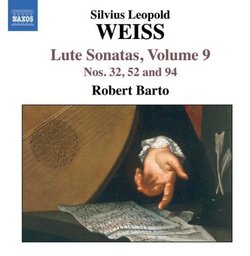| All Artists: Weiss, Barto Title: Weiss: Lute Sonatas, Vol. 9; Nos. 32, 52 and 94 Members Wishing: 0 Total Copies: 0 Label: Naxos Original Release Date: 1/1/2008 Re-Release Date: 4/29/2008 Genre: Classical Styles: Chamber Music, Historical Periods, Baroque (c.1600-1750), Classical (c.1770-1830), Instruments, Strings Number of Discs: 1 SwapaCD Credits: 1 UPC: 747313055173 |
Search - Weiss, Barto :: Weiss: Lute Sonatas, Vol. 9; Nos. 32, 52 and 94
 | Weiss, Barto Weiss: Lute Sonatas, Vol. 9; Nos. 32, 52 and 94 Genre: Classical
|
Larger Image |
CD DetailsSimilar CDs |
CD ReviewsBest of the bunch so far Kidneykutter | Cleveland, OH USA | 07/02/2008 (5 out of 5 stars) "This is the 9th in the series of Weiss sonatas (suites) by Bob Barto, the world expert at playing this music on baroque lute. His playing and sound seem to get better with every release. Particularly on this disc, he takes more adventurous chances with ornamentation on the repeats. Buy this disc, then be stunned, then buy the previous 8." Amazon was Right! Robin Friedman | Washington, D.C. United States | 07/28/2009 (4 out of 5 stars) "For months, this CD of lute music by Silvius Leopold Weiss has appeared in the "Recommended for you" section of my Amazon page. I have listened to a substantial amount of baroque music but hadn't heard Weiss before. I decided to check the accuracy of Amazon's computer in referring me to music I didn't know. And, indeed, Amazon was right. I enjoyed this CD and found myself wanting to hear more of Weiss.
Weiss (1687 -- 1750) was a contemporary and acquaintance of both J.S. Bach and Domenico Scarlatti. His music has some of the characteristics of both of these far better-known composers. Scarlatti is remembered today primarily for his 550-odd short sonatas for solo keyboard. Weiss was renowned in his day as the leading performer on the lute. Although we wrote much else, Weiss has become known as perhaps the greatest composer for this difficult instrument. Scarlatti's sonatas moved relatively easily to the piano when the harpsichord became, for a time obsolete. But with the disappearance of the lute, Weiss's music became obscure until the 20th Century revival of interest in early music. Scholars have since poured over and assembled definitive editions of Weiss's prolific work for the instrument, consisting of at least 391 individual movements. Weiss's music for lute is arranged in the form of multi-movement sonatas, similar to Bach's French or English Suites for keyboard and the celebrated solo music for cello and violin. The works thus usually consist of between five and seven movements using a variety of dance forms. The bodget-priced Naxos series is in the process of recording Weiss's complete lute music performed by Robert Barto, a contemporary master of the instrument. This particular CD, which kept appearing on my recommended list, is the ninth and most recent of the series. The beautiful, deep and bell-like tone of Barto's playing makes this music immediately appealing. The music is both dance-like and contrapuntal. Weiss uses the full 13 (or earlier 11) stings of the lute to allow contrasting themes in the instrument's different registers. As does Bach in the cello and violin works, Weiss also has the ability to suggest several fugal voices within the resources of a single instrument. The works on this CD have an introspective, improvisatory character. Even though they were performed in public, these works are highly intimate, as if the performer is playing quietly for himself or for a small audience of close friends. The CD consists of three sonatas which, according to the scholarly liner notes of Tim Crawford, were composed at different times in the composer's life and reflect his evolving style. The sonata no 52 in C minor is an extended 30-minute work in six movements. It features a massive opening overture with a slow, grave opening section, followed by a fugue, and a vivace concluding section. The third movement is a lovely bell-like and lively bouree. The fourth movement of this piece is a flowing, gently rocking graceful sicilliana rather than the more usual sarabande. The work concludes with a virtuosic, concertante-style presto. The sonata no. 32 in F major consists of seven movements but is substantially shorter (it runs about 22 minutes) that the C minor sonata. It opens with a slow, dignified allemande followed by a courante in which the melody flows over strumming on the lower strings of the lute. There is a lively bouree and a stately sarabande which is the climax of the work. There are two short contrasting minuets, and the sonata concludes with a short rhythmic gigue in triplets. The final work, the five-movement sonata no 94 in G minor is about thirteen minutes in length. The manuscript of this piece is found only in a Russian collection, and it was apparently taken to Russia by a student of Weiss. This short work has a wide variety of contrasts in mood, from the sad opening andante to the short, spiky paisane. Interestingly, the fourth movement of this work is a Polonaise, a Polish dance that Bach and Beethoven also used, sparingly, and that Chopin immortalized. The work again concludes with a short sprightly gigue. This music remains off-the beaten path, but it will appeal to listeners who enjoy Scarlatti's keyboard sonatas and Bach's instrumental music. I look forward to hearing more of Weiss's music as performed by Robert Barto. Robin Friedman " |

 Track Listings (18) - Disc #1
Track Listings (18) - Disc #1![Puccini - Tosca / Miricioiu · Lamberti · Carroli · Rahbari [Highlights]](https://nationalbookswap.com/cd//m/19/3119/6013119.jpg)


